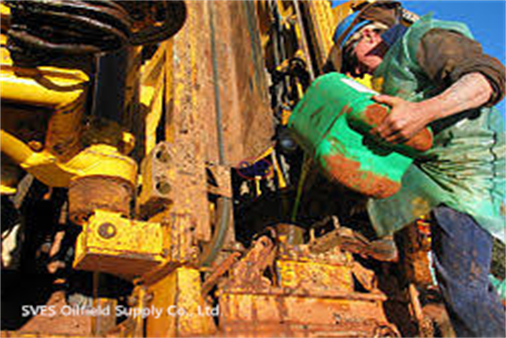
200 questions on drilling knowledge - Drilling Fluid
2024-05-25 10:00200 questions on drilling knowledge - Drilling Fluid
No. 2. DrillingDrilling Mud fluidDrilling Fluid

26. What are the main functions of drilling fluid?
Answer:
1. Carry cuttings
2. Suspended rock cuttings
3. Cool and lubricate drill bits and drilling tools
4. Clean the scoured formation at the bottom of the well
5. Rely on liquid column pressure to balance oil and gas layer pressure and prevent blowout
6. Prevent well collapse and stabilize well wall
7. Carry out cuttings logging through circulation
8. Help turbine or diner drilling tools transmit power.
27. What main drilling fluid chemicals should be prepared before drilling into a salt layer or salt gypsum layer?
Answer: Caustic soda, soda ash and iron chromium salt.
28. Please write down five commonly used leak-stopping materials?
Answer: 1. Asbestos powder 2. Clam shell powder (slag) 3. Mica powder 4. Colloidal cement 5. Cottonseed shell or peanut shell.
29. Please write down five drilling fluid weighting materials?
Answer:
1. Barite (BaSO4)
2. Lime powder (CaCO3)
3. Iron oxide powder (Fe2O3)
4. Ilmenite powder (FeTiO3)
5. Specularite powder (FeCO3·Fe2O3)
30. Please write down five commonly used drilling fluid materials that reduce viscosity, shear force, and water loss?
Answer: 1. Caustic soda 2. Tannin 3. Tannin 4. Coal alkali agent 5. Iron chromium salt
31. Please write down five commonly used drilling fluid materials that increase viscosity, increase shear force, and reduce water loss?
Answer:
1.CMC (carboxymethylcellulose)
2. Glauber's salt (sodium sulfate)
3.Sulfonated asphalt
4.Polyacrylamide
5. Modified asbestos
32. What specific content does the drilling fluid performance measured at the current drilling site include?
Answer: 1. Density 2. Viscosity 3. Water loss 4. Mud cake 5. Initial shear force/final shear force 6. Sand content 7. Solid content 8. Oil content 9. PH value
33. If the drilling fluid loses too much water, what impact will it have on drilling operations?
Answer:
1. Too much water loss from the drilling fluid will thicken the mud cake, increase the frictional resistance between the drilling tool and the well wall, and easily cause sticking.
2. Under the pressure of the drilling fluid column, it penetrates into the well wall, causing some formations that expand when exposed to water to shrink or collapse, and even cause drill sticking.
3. Due to the diameter reduction in the well, the piston often appears to be pulled out when drilling.
34. What impact does high drilling fluid density have on drilling operations?
Answer:
1. Slow down the drilling speed
2. It is easy to cause pressure differential stuck
3. Sometimes the ground layer is pressed and leaked
4. The frictional resistance increases when lifting or lowering the drilling tool.
5. Poor fluidity, resulting in increased pump pressure.
35. What impact does excessive sand content in drilling fluid have on drilling operations?
Answer:
1. It is easy to puncture the hydraulic end accessories of the drilling pump and shorten the life of the valve seat, valve body, piston, cylinder liner, packing and other parts;
2. It is easy to puncture the downhole drilling tools and drill bit water holes;
3. It is easy to puncture the elbows of ground high-pressure pipelines and assembly gates;
4. If the drilling fluid in the well remains static for too long, it will precipitate and form a sand bridge, causing the drilling to be blocked or stuck;
5. If it remains stationary in the circulation tank for a long time, precipitation will also occur. Cleaning the circulation tank requires a lot of labor and is a hard job;
6. Directly affects the stability of drilling fluid density.
36. When drilling a well in an area where the quicksand layer (surface layer) is relatively loose, what are the specific requirements for drilling fluid when installing surface casing?
Answer: 1. You cannot drill with clean water, you must use drilling fluid; 2. The drilling fluid must have an appropriate viscosity before running casing, generally not less than 40 seconds; 3. Use the sand remover well, and try to remove the viscosity of the drilling fluid as much as possible. The amount of sand should be kept low; 4. Reduce water loss as much as possible.
37. In order to reduce frictional resistance, what are the main precautions when mixing crude oil into drilling fluid?
Answer:
1. Pay attention to fire prevention and prepare fire extinguishers;
2. Calculate how much the density will drop after mixing with oil, and pay attention to the aggravation;
3. Prepare the emulsifier to prevent the crude oil from emulsifying in the drilling fluid; 4. Control the oil mixing speed, preferably in several cycles, and mix it in slowly and evenly; 5. Carefully check whether the blowout preventer is flexible and easy to use.
38. What "five precautions" should we pay attention to when storing drilling fluid chemicals?
Answer: 1. Protect against moisture; 2. Protect against fire; 3. Protect against sunlight; 4. Protect against freezing; 5. Protect against poisoning.
39. When using drilling fluid chemicals, how should they be added appropriately?
Answer:
1. Calculate the required quantity first;
2. If it is a liquid, it can be dripped in according to the cycle or in small displacement;
3. If it is a powdered medicine, it can be hydrated evenly first, and then dripped or flowed in according to the cycle. If the hydration conditions are not met, it can be added through the mixing funnel on time and evenly according to the cycle;
4. If too much liquid medicine is added, consider increasing the dosage appropriately.
40. What are the three main types of drilling fluids?
Answer: 1. Water-based drilling fluid; 2. Oil-based drilling fluid; 3. Emulsified drilling fluid.
41. Please write the names of five drilling fluids?
Answer:
1. Freshwater drilling fluid;
2. Calcium treated drilling fluid;
3. Salt water drilling fluid;
4. Saturated brine drilling fluid;
5. Low phase drilling fluid.
42. What will happen to the viscosity of the drilling fluid when drilling into the gypsum layer?
Answer: Increase.
43. What are the obvious changes in drilling fluid performance when drilling into salt rock formations?
Answer: The viscosity increases, the water loss increases, the mud cake thickens, the shear force increases, the salt content increases sharply, and the PH value decreases.
44. If the density of drilling fluid is high, what methods are usually used to reduce the density of drilling fluid, and which method is better?
Answer: There are two main methods: one is to add water to prepare drilling fluid chemicals; the other is to use a centrifuge. Using a centrifuge has a better effect of reducing the density. Only reducing the density does not affect other properties. Adding water reduces the density faster, but it affects other properties, so some other chemicals must be added.
45. Please indicate the names of the following five medicines in Chinese characters?
Answer: Na2CO3 soda ash; NaOH caustic soda; BaSO4 barite (barium sulfate); CaCO3 limestone (calcium carbonate) CaCl2 calcium chloride.
